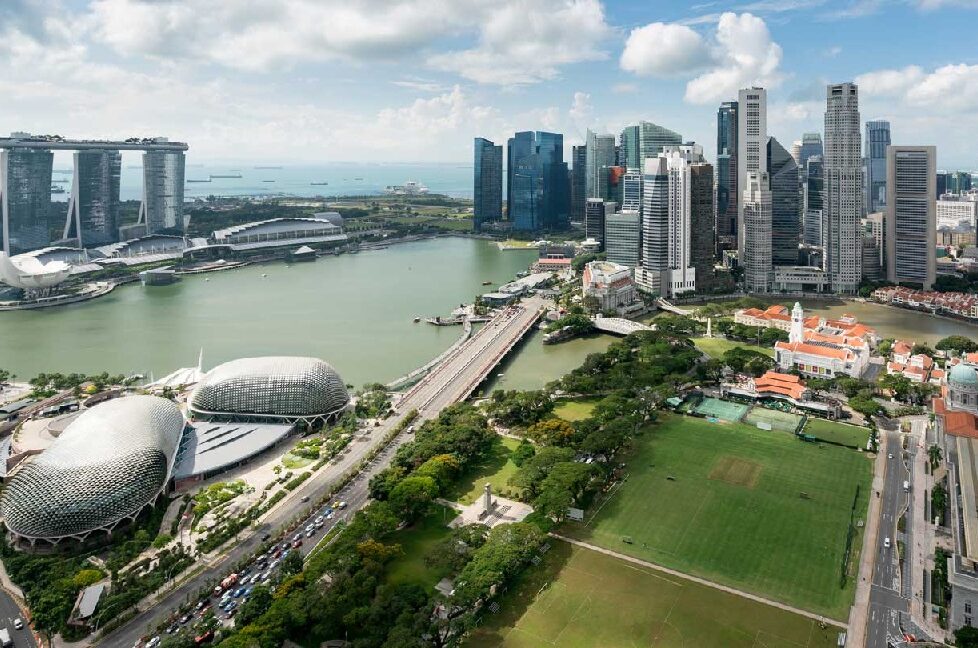Singapore to Ramp Climate Goals at COP27, Launches National Hydrogen Strategy

Singapore plans to submit a more ambitious emissions reduction goal at the upcoming COP27 climate conference in November, according to Deputy Prime Minister Lawrence Wong, as part of a strengthened commitment to achieve net zero by 2050.
As a key part of Singapore’s climate plans, Wong also unveiled a National Hydrogen Strategy, aimed at moving as much as half of the nation’s power supply to hydrogen by mid-century.
Singapore’s announcement comes as countries globally are being urged to ramp their climate commitments in the run-up to COP27. One of the key highlights of last year’s COP26 conference’s final agreement, the Glasgow Climate Pact, was a call on countries to revisit and strengthen their 2030 emissions targets, or Nationally Determined Contributions (NDCs). A UNFCCC report released last week, however, revealed that very few countries have met their pledges to update their NDCs.
In a speech at Singapore International Energy Week last week, Wong revealed new 2030 emissions reduction targets that will serve as Singapore’s updated NDC. Singapore had previously set a goal to reach peak emissions around 2030, at 65 million tonnes of CO2 equivalent. The new goal will see the nation aim to hit peak emissions earlier, and to reach around 60 million tonnes of CO2 equivalent in 2030.
Wong said:
“At last year’s UN Climate Change Conference in Glasgow, or COP-26, countries were urged to get to net zero emissions by or around the middle of the century.
“Singapore has heeded this call.”
Wong also said that Singapore is aiming to achieve net zero by 2050, signifying a more formal goal than its existing target to reach net zero emissions by around mid-century, in itself a recent strengthening of a prior commitment of halving emissions by 2050 and achieving net zero “as soon as viable in the second half of the century.”
The Deputy PM noted that net zero 2050 is a “stretch target” for Singapore, particularly as the nation has “limited options to deploy renewable energy at scale,” lacking land for substantial solar or wind deployment or rivers for hydroelectric power generation.
Wong outlined several of the strategies the country aims to pursue to achieve its climate goals, including the new hydrogen strategy. Power accounts for around 40% of Singapore’s emissions, with the sector currently heavily dependent on natural gas. With only limited capability to generate power from renewable energy or import clean energy, Wong indicated that Singapore aims to turn to hydrogen as a clean energy source, noting its benefits including not emitting CO2 when used as a fuel, its potential to be imported from diverse source countries, and the possibility of using hydrogen as a feedstock for hard to electrify sectors, such as aviation and maritime.
The deployment of low carbon hydrogen capacity at scale, however, will require significant investments and advancements, including technological and infrastructure development. Singapore’s new hydrogen strategy includes exploring key hydrogen technologies and carrier pathways to understand the potential for large scale deployment, supporting hydrogen research and development, working with industry and international partners to facilitate global trade in low-carbon hydrogen and to establish supply chains, studying land and infrastructure requirements needed to deploy low-carbon hydrogen in the longer-term, and preparing the workforce for the hydrogen transition.
Wong also highlighted the importance of developing green finance in order to channel the trillions of dollars in capital necessary to facilitate the low carbon transition. Singapore has emerged as a hub for financial services companies and ESG-focused data providers looking to capitalize on the growing ESGEnvironmental, social, and governance (ESG) criteria are a set of standards for a company’s operations that socially conscious investors use to screen potential investments. More and sustainable finance opportunities in the Asian market, and has launched several initiatives, such as “Project Greenprint,” to help mobilize capital for green and sustainable finance by harnessing technology and data and create a more transparent, trusted and efficient ESGEnvironmental, social, and governance (ESG) criteria are a set of standards for a company’s operations that socially conscious investors use to screen potential investments. More ecosystem. Singapore also recently issued its first green bond, kicking off a multi-year program aimed at raising up to S$35 billion to fund the country’s sustainable transition strategy.
Other initiatives highlighted by the Deputy PM included raising the carbon tax and new public sector commitments.
Singapore introduced a carbon tax in 2019, setting a price for emissions above a minimum level at $5 per tonne. Under Singapore’s recently released budget 2022, the country plans to raise the carbon tax significantly to $25 per tonne in 2024, $45 in 2026, and between $50 to $80 per tonne by 2030.
The government’s new commitments include achieving net zero emissions across the public sector by around 2045, and for all public sector cars to run on clean energy by 2035.
Wong said:
“As you can see, our net zero path is not an easy one. But we have chosen to boldly commit ourselves to this journey because we believe we have a responsibility to do our part in this global climate transition effort.
“We will do our part to accelerate our green transition and achieve net zero, because we want to leave behind a greener and better country for our future generations of Singaporeans.”
The post Singapore to Ramp Climate Goals at COP27, Launches National Hydrogen Strategy appeared first on ESG Today.